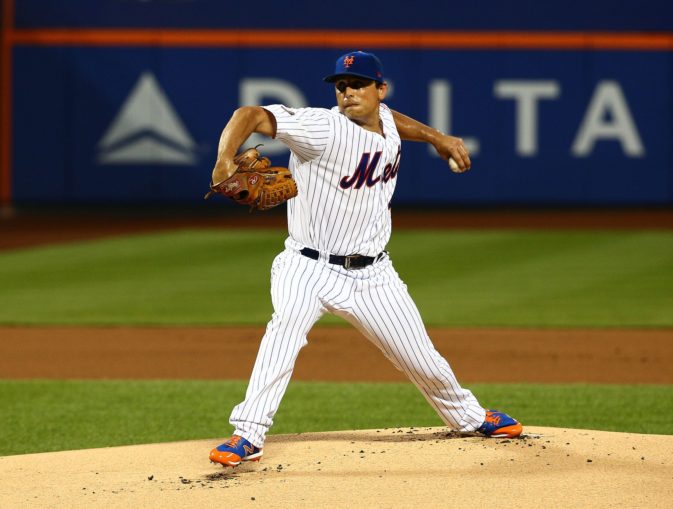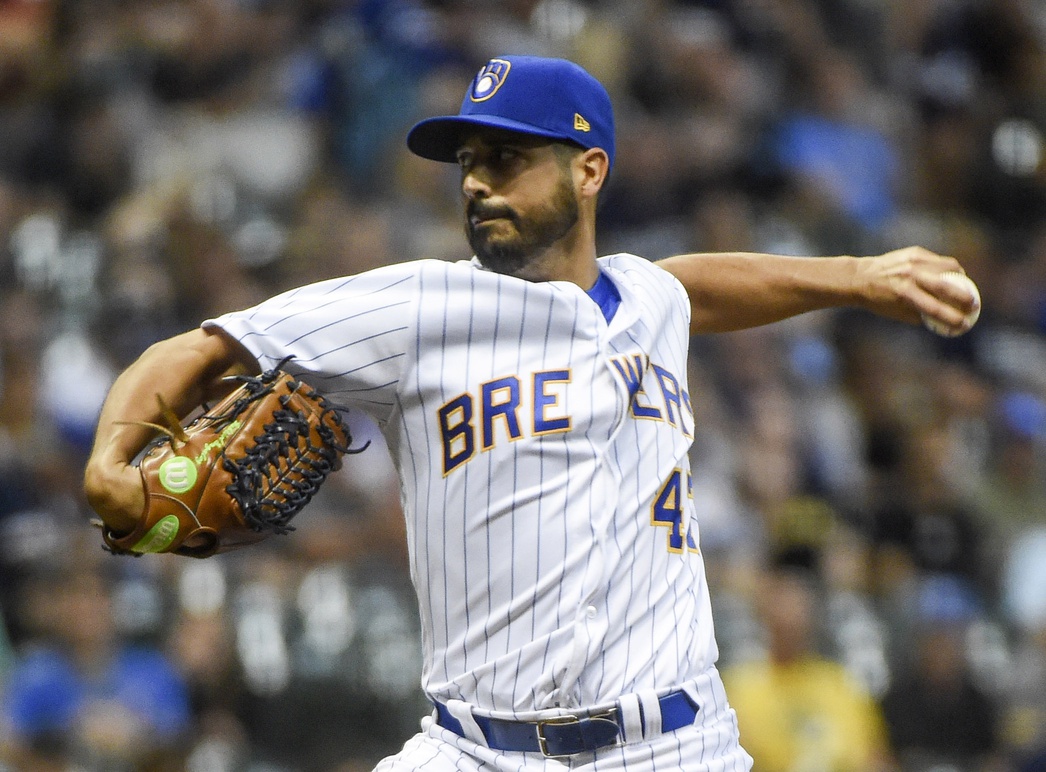
Baseball is going to be played this month, which is incredibly exciting, but it’s not so exciting for the mounds of MLB free agents still in search of a home for 2019. However, with an active general manager leading the way like Brodie Van Wagenen, we can be sure the New York Mets will at least stay engaged in the market, even if they don’t make another move.
While big names like Manny Machado, Bryce Harper, and Marwin Gonzalez are currently available, it looks as though BVW is focusing on rotation depth. There’s good reason for that — Jacob deGrom, Noah Syndergaard, and Zack Wheeler appear to be a formidable top three, but Jason Vargas and Steven Matz rounding out the rotation provides a few more question marks. Even with guys like Walker Lockett, Corey Oswalt, and Hector Santiago currently serving as rotation depth, the old adage is that a team can never have enough pitching.
The Mets would rather continue solidifying their depth in this area of the roster instead of disrupting their current starting five. That still hasn’t stopped them from maintaining a dialogue with free-agent Gio Gonzalez, one of the most accomplished starters currently in need of a job. If he were to hypothetically sign with the Mets, the most obvious candidate to move from the rotation is Vargas.
So with that in mind, let’s do a little comparing and contrasting.
A Very Different, But Kinda Similar 2018
When looking at the cumulative statistics of Vargas and Gonzalez, there’s no contest as to which hurler has enjoyed the better career. It’s also not a contest when trying to figure out who put together a better 2018.
Across 171 innings for the Washington Nationals and Milwaukee Brewers, Gonzalez posted a 4.21 ERA with a 19.8% strikeout rate and 10.7% walk rate. Those numbers don’t jump off the page, but he was worth 2.0 fWAR, the ninth straight year he hit that particular benchmark. It was also the eighth time in nine years in which he tossed at least 170 frames. On the other hand, Vargas compiled just 92 innings and struggled to a 5.77 ERA with a 20.8% strikeout rate, 7.4% walk rate and 0.1 fWAR.
If we break each of their respective seasons into separate halves, though, we can see where the similarities lie — even if the rough patches didn’t happen at the same time. Here’s what Gonzalez’s first half/second half splits look like:
| Gonzalez | IP | ERA | WHIP | wOBA | K% | BB% |
|---|---|---|---|---|---|---|
| First Half ’18 | 101.2 | 3.72 | 1.46 | .321 | 21.2% | 10.8% |
| Second Half ’18 | 69.1 | 4.93 | 1.43 | .318 | 17.8% | 10.6% |
And here’s what Vargas’ splits look like when using the same scenario:
| Vargas | IP | ERA | WHIP | wOBA | K% | BB% |
|---|---|---|---|---|---|---|
| First Half ’18 | 37.2 | 8.60 | 1.83 | .428 | 17.8% | 7.8% |
| Second Half ’18 | 54.1 | 3.81 | 1.12 | .288 | 23.2% | 7.1% |
The sample sizes are lopsided — and Vargas’ struggles were much more pronounced — but there’s a bit of symmetry going on here. Each veteran southpaw actually finished 2018 on a high note thanks to a strong September.
This is where their respective workloads just about evens out. Check out how each performed during 2018’s final month:
| September ’18 | IP | ERA | WHIP | wOBA | K% | BB% |
|---|---|---|---|---|---|---|
| Gio Gonzalez | 25.1 | 2.13 | 0.95 | .229 | 22.0% | 10.0% |
| Jason Vargas | 22.0 | 3.27 | 0.91 | .254 | 25.8% | 5.6% |
Comparing Peripheral Stats
Since both Gonzalez and Vargas finished with a flourish, we can further differentiate the two by checking out their peripheral stats to see which is more sustainable moving forward.
For Gio, his last 25.1 regular-season innings came with the Brewers after getting acquired prior to the waiver trade deadline. After posting a 7.47 ERA with Washington in August, this was the turnaround Milwaukee was hoping for. But why haven’t they — or anyone else, for that matter — signed him for 2019?
Well, a lot of the numbers he posted during this final stretch make it seem like it won’t hold up. Opposing hitters slashed just .156/.240/.270 against Gonzalez in September, but he accomplished this while also posting a .182 BABIP, 80.2% strand rate, and 13.6% line-drive rate. While those BABIP and strand rate numbers somewhat mirror what he did during a resurgent 2017, it’s a pretty rare sight when looking at the rest of the season-long numbers throughout his career.
Vargas’ September peripherals don’t look much different — he held opposing hitters to a .181/.239/.341 line with a .196 BABIP, 77.9% strand rate, and 14.5% line-drive rate. However, he did limit hard contact to a 33.3% rate during the month, which was on the lower side when looking at his monthly performance. Hitters produced hard contact at a 38.2% clip against Gonzalez, which was the second-highest number he produced for any month last season.
Is this splitting hairs? Yes, but it’s also worth noting that Vargas’ peripherals mostly stand up throughout a prolonged stretch in which he looked like a big-league pitcher again. His second half included a .259 BABIP against, 73.3% strand rate, 19.7% line-drive rate, and 32.5% hard-hit rate (his career numbers in those areas are .286, 73.0%, 19.8%, and 29.1%, respectively).
Mets Have Right to be Picky
Gonzalez brings value simply for his durability — he’s made at least 30 starts every single year except one since 2010 (he made 27 starts in 2014). While it’d also seem that he’d provide a boost with regard to actual production, it doesn’t seem so cut-and-dry. Gio is likely looking for more than a one-year deal, along with a guaranteed rotation spot because of his track record.
At the moment, neither of those things appear to be on the table with the Mets:
Mets interest in Gio Gonzalez is not currently at multiyear level, so for it to fit, one side would have to budge off their current stance/expectations
— Andy Martino (@martinonyc) February 2, 2019
Vargas’ horrendous first half wasn’t fun to watch, but if the Mets believe he sincerely turned it around in the second half, their current level of interest in Gonzalez makes sense. A slow-moving free-agent market gives Van Wagenen a chance to continue fortifying the roster, but also doing so on his own terms.
We know enough about BVW to know that Gonzalez isn’t the only starting pitcher the organization has talked about or have had conversations with. There are others available that fit what the Mets are looking for.
If a compromise with Gio’s camp doesn’t come and New York opts for another depth signing for the rotation, let’s hope Vargas has a normal Spring Training. That’ll allow him to appropriately ramp up his workload prior to Opening Day, and not have everything derailed by a freak accident — like breaking his hand on a comebacker a week before the season starts.
Would I prefer Gonzalez over Vargas in an ideal scenario? Yes because of everything he can bring to the table, but I also wouldn’t want the Mets to be bidding against themselves in a market that has been mostly silent for the veteran lefty. It’s already February, why not wait it out a little bit longer before camp starts to see if they can make this happen on their own terms?
















